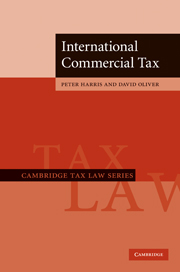Book contents
- Frontmatter
- Contents
- Preface
- List of abbreviations
- Table of Cases
- Table of statutes
- Table of treaties
- Introduction
- 1 Fundamentals and sources of international tax law
- 2 The jurisdiction to tax
- 3 Source country taxation
- 4 Residence country taxation
- 5 The limited scope of treaties
- 6 Changes of source and residence
- 7 Bilateral administrative issues
- Conclusion
- References
- Index
5 - The limited scope of treaties
Published online by Cambridge University Press: 03 May 2011
- Frontmatter
- Contents
- Preface
- List of abbreviations
- Table of Cases
- Table of statutes
- Table of treaties
- Introduction
- 1 Fundamentals and sources of international tax law
- 2 The jurisdiction to tax
- 3 Source country taxation
- 4 Residence country taxation
- 5 The limited scope of treaties
- 6 Changes of source and residence
- 7 Bilateral administrative issues
- Conclusion
- References
- Index
Summary
Discussion in previous chapters has identified myriad limitations of tax treaties and, in particular, the OECD Model. A disconcerting feature of this is that what has been discussed are the things that treaties do cover. EU Law can be a useful supplement to fill the gaps and, perhaps, right wrongs, but EU Law has its limitations as well. One continual problem is the interaction between domestic law and tax treaties. A particular feature of this is trying to determine whether a term used in a treaty has a special treaty meaning or whether it derives its meaning from domestic law, i.e. the Article 3(2) issue. A classic example of this is use of the word ‘income’ in Articles 6 and 21, but other cases have been discussed that involve difficulties. For example, problems with the terms ‘immovable property’, ‘alienation’, ‘movable property’ and ‘employment’ have been discussed, among many others. In some cases, the difficulties arise from specific definitions inserted in tax treaties, such as the definitions of ‘dividends’, ‘interest’ and ‘royalties’.
A sceptic might suggest that the more we learn about tax treaties, the more we understand how little they cover and the more we realise that what they do cover often involves distortions. A major example is the presumption of a classical system with the bias for debt over equity financing that this involves.
- Type
- Chapter
- Information
- International Commercial Tax , pp. 343 - 415Publisher: Cambridge University PressPrint publication year: 2010



